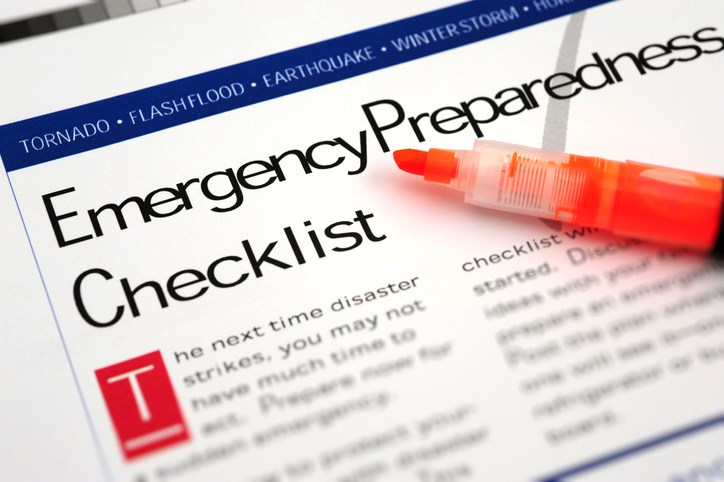The next time a major flood, fire, tornado, natural disaster, or train derailment affects the area, Moose Jaw’s emergency measures organization (EMO) office will swing into action to address the situation.
“Our operating procedure is to provide protection, give advanced notice or warning, and do everything in our best ability to keep everyone within the area safe,” said Mike Russell, deputy fire chief and EMO co-ordinator.
When responding to an emergency, the EMO office must determine whether it should activate an emergency operations centre (EOC) and at which severity level it should start, he continued. This can be a fluid situation since there are many factors to consider and decisions to make.
If a response is required outside of the normal EMO operations, such as a train derailment, several agencies would be involved and the municipality might send heavy equipment to assist, noted city manager Jim Puffalt. Therefore, the EOC would have powers to bring in more resources — provincial and federal — to manage the disaster.
Working behind the scenes
The last time the EMO office nearly activated its EOC was in December 2019 during a major power outage. The office was one hour away from making the call before learning that SaskPower was resolving the matter.
The office did not need to call in any of its partners at that time, Russell said. Instead, he and Puffalt met to review logistics, operations, planning and finances. The office also provided regular updates to the provincial government.
The EMO office and municipality can handle almost every emergency by using resources already here. Sometimes there may not be a need to declare a state of emergency.
Some partners involved with emergency preparedness include the Red Cross, search and rescue, Salvation Army, the Saskatchewan Health Authority, and national and federal agencies. The EMO office also communicates with both school divisions, SaskPower, SaskEnergy, and Gibson’s Refinery.
Pandemic keeps EMO active
Russell and his team are currently in a quasi-state of emergency with the pandemic. He explained that he and Puffalt began preparing in February 2020 by declaring a level 1 emergency operations centre and having daily planning meetings to decide when to close public buildings. They also kept EOC members updated.
“We’re still doing that, but it’s scaled down,” he said, noting he continues to receive regular updates from the province and Saskatchewan Health Authority. He also spoke regularly with a federal agency dedicated to emergency response and recovery.
Dealing with floods
In 2011 the City of Estevan declared a state of emergency because major floods hit the area. Puffalt was the city manager there and recalled how intense those weeks were. At one point, he attempted to convince Transport Canada to let a helicopter drop off materials at the water treatment plant since water surrounded it.
“When these things happen … you got to be flexible and fluid and be able to roll with it because there’s no manual for this,” he added.
The EMO office has an in-depth plan when responding to emergencies, while it also ensures everyone involved with the organization is trained on how to respond to situations, Russell said. The office reviews its plan and manual regularly, holds table-top exercises — usually during non-pandemic times — and ensures the response plan meets the needs of Moose Jaw and area.
Possible evacuations
Evacuating people depends upon the situation, he continued. For example, the EMO office was in regular contact with the Red Cross and Sask. Polytechnic during the December 2019 ice storm. People in vulnerable sectors would have been evacuated first to the college, especially if the power had stayed out for hours.
The group also checked if it had generators, fuel for machines and vehicles, other available buildings, and water supplies.
“These things were happening in the background while we were waiting for the power to come back on … ,” said Russell. “There is lots done behind the scenes that people don’t really know about.”
Handling forest fires
The EMO office could also respond to evacuations where people come from other affected areas, said Puffalt.
When he was city manager in North Battleford in 2016, major fires ripped through northern Saskatchewan and forced hundreds of residents to relocate south. That city had to provide these people with food and entertainment, which included giving them access to recreational activities and venues.
While fires are a concern here, very few people will ever be affected by floods, said Fire Chief Rod Montgomery. Plenty of mitigation efforts have been implemented to prevent flooding downtown, so it would have to be a 1-in-500-year flood to have a catastrophic effect.
Responsibility for decision-making
Once a state of emergency is declared, the decision-making responsibility falls on the mayor and city manager, with the latter becoming head of the EOC, said Russell. Depending upon the severity, this declaration allows the EMO office to request and access resources from the provincial and federal governments.
While facing disasters might be scary, Russell encourages residents not to panic, be prepared, and have a plan to shelter in place for 72 hours.
“We are doing a lot (behind the scenes); we are safe in this community,” he added. “We feel we’re safe and we’re ready should anything happen.”
Residents should be responsible for their own protection and safety, including having on hand cash, medication, food and other supplies, echoed Montgomery. People should not shirk their responsibility since the onus is on them to be part of the solution.
More information about emergency survival can be found at www.redcross.ca.
Other resources include:




